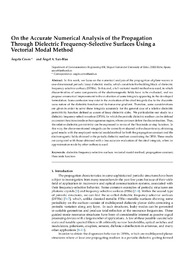Por favor, use este identificador para citar o enlazar este ítem:
https://hdl.handle.net/11000/30154Registro completo de metadatos
| Campo DC | Valor | Lengua/Idioma |
|---|---|---|
| dc.contributor.author | Coves, Angela | - |
| dc.contributor.author | San-Blas, Angel-Antonio | - |
| dc.contributor.other | Departamentos de la UMH::Ingeniería de Comunicaciones | es_ES |
| dc.date.accessioned | 2023-11-14T09:43:00Z | - |
| dc.date.available | 2023-11-14T09:43:00Z | - |
| dc.date.created | 2021-03 | - |
| dc.identifier.citation | Electronics Volume 10 Issue 7 | es_ES |
| dc.identifier.issn | 2079-9292 | - |
| dc.identifier.uri | https://hdl.handle.net/11000/30154 | - |
| dc.description.abstract | In this work, we focus on the numerical analysis of the propagation of plane-waves in one-dimensional periodic lossy dielectric media, which constitute the building block of dielectric frequency-selective surfaces (DFSSs). To this end, a full-vectorial modal method was used, in which discontinuities of some components of the electromagnetic fields have to be evaluated, and we propose a numerical improvement in the evaluation of some integrals appearing in the developed formulation. Some confusion may exist in the evaluation of the cited integrals due to the discontinuous nature of the dielectric function and its transverse gradient. Therefore, some considerations are given in order to solve these integrals accurately for the general case of a relative dielectric permittivity function defined as a sum of lossy dielectric slabs. We particularize our study to a dielectric frequency-selective surface (DFSS), for which the periodic dielectric medium can be defined as constant functions inside an homogeneous region, whose contours define the discontinuities. Thus, the relative dielectric permittivity can be expressed in terms of the Heaviside or step function. In this way, the above-mentioned integrals can be correctly evaluated in the discontinuity, obtaining good results with the employed vectorial modal method for both the propagation constant and the electromagnetic fields obtained in the periodic dielectric medium constituting the DFSS. These results are compared with those obtained with a less accurate evaluation of the cited integrals, when an approximation made by other authors is used. | es_ES |
| dc.description.sponsorship | This research was funded by a grant (No. PID2019-103982RB-C43 [AEI/FEDER, UE]) from the Agencia Estatal de Investigación (AEI) and from the EU through the Fondo Europeo de Desarrollo Regional—FEDER—“A way to build Europe”. | - |
| dc.format | application/pdf | es_ES |
| dc.format.extent | 11 | es_ES |
| dc.language.iso | eng | es_ES |
| dc.rights | info:eu-repo/semantics/openAccess | es_ES |
| dc.rights | Attribution-NonCommercial-NoDerivatives 4.0 Internacional | * |
| dc.rights.uri | http://creativecommons.org/licenses/by-nc-nd/4.0/ | * |
| dc.subject | dielectric frequency | es_ES |
| dc.subject | selective surface | es_ES |
| dc.subject | vectorial modal method | es_ES |
| dc.subject | propagation constant | es_ES |
| dc.subject | Heaviside function | es_ES |
| dc.subject.other | CDU::6 - Ciencias aplicadas::62 - Ingeniería. Tecnología::621 - Ingeniería mecánica en general. Tecnología nuclear. Electrotecnia. Maquinaria::621.3 - Ingeniería eléctrica. Electrotecnia. Telecomunicaciones | es_ES |
| dc.title | On the Accurate Numerical Analysis of the Propagation Through Dielectric Frequency-Selective Surfaces Using a Vectorial Modal Method | es_ES |
| dc.type | info:eu-repo/semantics/article | es_ES |
| dc.relation.publisherversion | Https://doi.org/10.3390/electronics10070766 | es_ES |

Ver/Abrir:
Electronics_2021.pdf
357,24 kB
Adobe PDF
Compartir:
 La licencia se describe como: Atribución-NonComercial-NoDerivada 4.0 Internacional.
La licencia se describe como: Atribución-NonComercial-NoDerivada 4.0 Internacional.
.png)